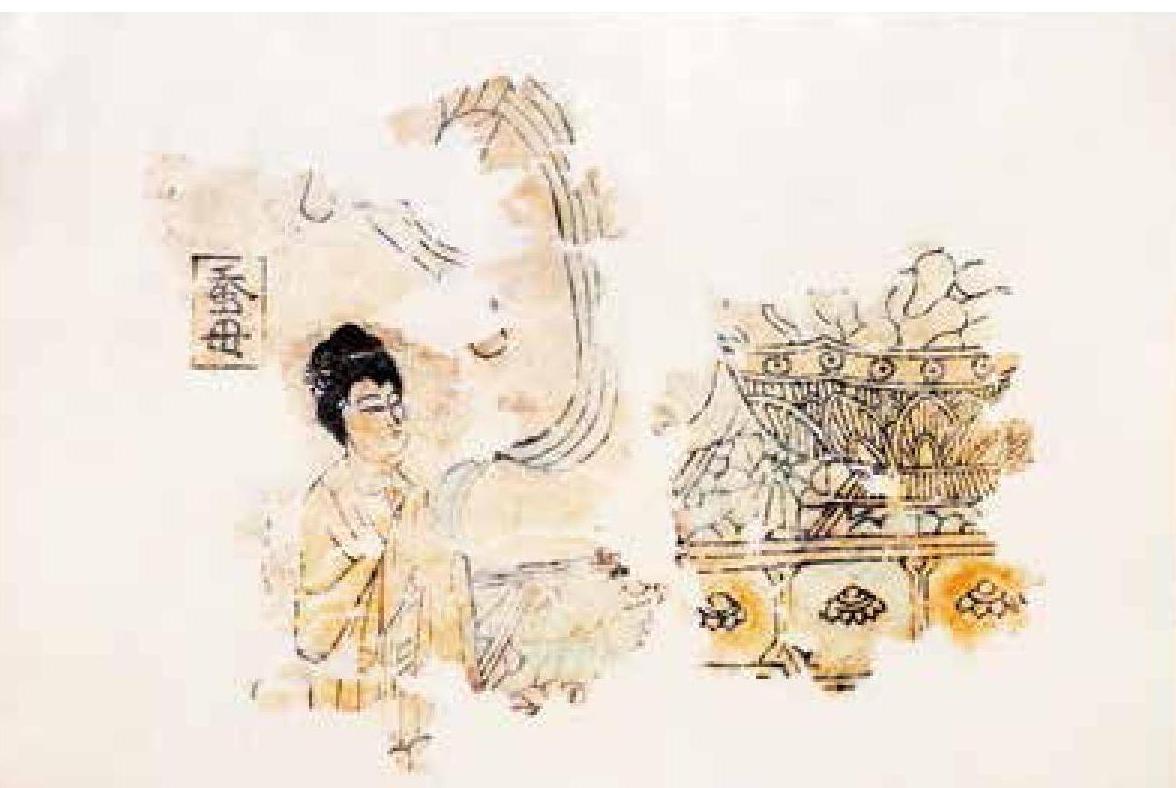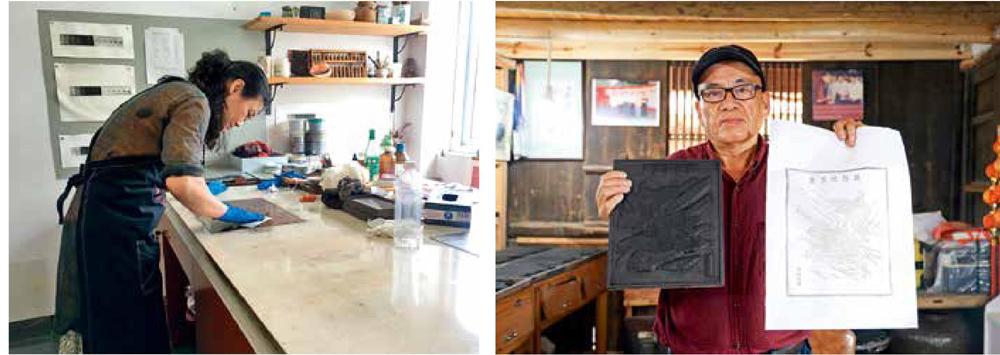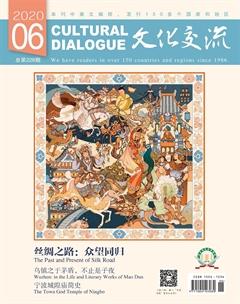温州版画艺术的前世今生
陈培培



画面以蚕母、蚕茧和吉祥图案等为主,较为完整地反映了北宋时期蚕神的形象和蚕茧丰收的场景,画面左上方的长方形字框内有直排的“蚕母”二字。
温州博物馆历史厅里展示的绝大多数是文物原件,有一件用的却是复制品,那是北宋时期的木刻套色版画《蚕母》。温州博物馆研究员伍显军说,这是从保护文物的角度出发,防止紫外线长期辐射对纸质文物的伤害,因此才用了复制品,原件则保管在库房中。
这幅《蚕母》目前是我国现存最早的木刻套色版画,它蕴藏了溫州桑蚕丝织业的历史痕迹。
前世:《蚕母》刻画北宋蚕神形象
1994年,温州博物馆的工作人员在整理国安寺石塔内发现的破损严重的一批印本、释道画时,发现了这幅木刻套色版画《蚕母》。
国安寺石塔,坐落在龙湾区皇岙村五峰山麓。1987年,浙江省文物局拨专款对该塔进行修缮。根据修复时发现的碑文,推断该塔建于北宋元祐庚午至癸酉年(1090~1093年)。
伍显军介绍,这幅《蚕母》藏于塔的第三层塔心方形石室内,同室内藏有北宋元祐辛未年(1091年)的碑记一方,因此可以断定它为北宋元祐时(至迟为1093年)或稍早的印刷品。
这幅《蚕母》局部残缺,但整体效果未受影响。画面以蚕母、蚕茧和吉祥图案等为主,较为完整地反映了北宋时期蚕神的形象和蚕茧丰收的场景。画面左上方的长方形字框内有直排的“蚕母”二字。左侧为蚕母立像,头梳高髻,髻上插花;面颊丰满圆润,白皙而带红晕;柳眉清秀,双目深沉,容光照人。
伍显军介绍,温州地区历来是桑蚕丝织业发达的地区。新石器时代的一些遗址,如乐清白石杨柳滩遗址、鹿城区上戍乡曹湾山遗址、鹿城区藤桥镇屿儿山遗址、瑞安市碧山镇山前山遗址、龙湾区上河滨村龙岗山遗址等,均发现有纺纱工具石纺轮或陶纺轮,说明温州先民已能将松散的细纤维质捻成麻花状线索,而用于缝制或编织。瑞安岱石山西周晚期至春秋初期的一座石棚墓扰土层中,采集到的一件原始瓷罐残片上堆塑有蚕纹。南朝刘宋时育蚕一年八熟。隋代,豫章、永嘉等地蚕一年四五熟,人们勤于纺绩,亦有夜浣纱而旦成布者,俗呼为“鸡鸣布”。北宋永嘉胡氏栽靛为业。宋代“温地不宜桑而织纴工”(陈谦《永宁编》),但是从北宋慧光塔发现团鸾纹红罗双面绣经袱和花枝纹褐罗双面绣经袱来看,温州的丝织和刺绣工艺在当时都有很大发展。
我国古代版画(木刻)历史悠久,比欧洲早五百多年,是世界版画的策源地。鲁迅先生在《木刻纪程》一书的小引中说:“中国木刻和图画,从唐到明,曾经有过体面的历史。”
隋唐之前的中国佛教石窟、寺院壁画中采用了漏印填彩技术。唐代,随着雕版印刷术的发明,书籍由写本时代进入印本时代。这时,刻书和版画技术有机地结合在一起。早期有木版捺印、木版刷印的佛教彩色版画。捺印是在印好的佛经图案上逐个印上色彩。刷版填色法则是采用雕版印刷与手工上色相结合的方法:先用雕版印刷术,在纸上印制出版画,然后在手工墨线版画上填涂各种颜色,使黑白图画变成彩色图画。套色印刷法是雕版印刷术发展过程中的新成就。套色印刷主要采用两种方式:一是单版涂色印刷,即用几种颜色涂在一块雕版上,然后覆纸印刷;一是套版印刷,则用两块或两块以上的版片,使用不同颜色,逐次印在同一纸上。
温州博物馆原馆长金柏东研究认为,这幅《蚕母》具备明显的雕版套色印刷特征,如线条刚劲、规整,帛巾、对襟的纤细线条,有轻微凹陷;线条粗细、浓淡不一,过渡欠自然,长线中有断线出现;“蚕母”两字,字体苍劲有力、干练明快,并设有长方形字框,与北宋版本字体及版画字框式样相一致;用色多样,色调明快、协调;色区边缘整齐。因此,可以断定这是一件北宋元祐时(至迟为1093年)或稍早的套色版画,应是我国现存最早的木刻套色版画之一。
伍显军表示,蚕母作为艺术形象留传下来的为数不多,早期的仅见宋代巨鹿遗址出土的人物雕版,该版尚可隐约看出“三姑置蚕大吉”六字,“疑是宋代民间供奉的蚕神神像雕版”。温州博物馆这幅《蚕母》,年代确切,且有“蚕母”二字,是被专家判定为现存最早反映蚕母形象的作品。
今生:非遗“三术”重现屏纸版画
那么,当年制作这幅《蚕母》的技艺,在如今的温州是否还有流传呢?
笔者来到瑞安平阳坑镇东源村,找到了今年63岁的王钏巧。他是瑞安仅有的11位木活字印刷术“谱师”之一,也是纸马雕版印刷术技艺的唯一传人,是目前瑞安独有的一位身兼两项传统技艺的“双料”省级非遗传承人。
只见他在纸马木雕版上刷一层墨,然后铺上一层宣纸,再用棕刷反复均匀按压……轻轻揭纸,一幅生动的《麒麟吐玉书》跃然眼前。
东源村是中国木活字印刷技艺的主要传承地,作为东源王氏后裔的王钏巧,幼时酷爱字画。1974年,18岁的他跟随堂叔祖王声初和堂兄王钏合学习传统的木活字印刷技艺及修谱技艺。至于纸马雕版印刷术,则是他在成家后,跟着妻子的家人学习的。但他天资聪颖、勤学苦练,很快就熟练地掌握了这两门技艺。
王钏巧说,东源的纸马雕版印刷品是民间祈福禳灾祭祀活动焚烧的各种各样雕版印刷品的总称,也是中国民俗版画体系中的特殊类型。该印刷术在明末清初之际由福建传入瑞安并传承至今,2014年被列入浙江省非遗名录。
20世纪80年代后期,时任泽雅区区长的周荣光提出了大力开发泽雅旅游业,近年他着手研究瓯海与瑞安两地的“三术”(造纸术、木活字印刷术、纸马雕版印刷术)融合问题,即将瑞安的木活字印刷术及纸马雕版印刷术呈现在泽雅屏纸上。2018年5月,他找到了王钏巧。王钏巧找出收藏多年的纸马雕版,用周荣光带来的屏纸制出了版画。
王钏巧说,现在他一直在新制雕版,拓宽题材,推动纸马雕版从祭祀民俗向装饰收藏功能转变。他甚至还设计了套色版,让屏纸版画形式感更强、色彩更丰富。而这种套色版,保留了最古老的套色版画的工艺,与这幅《蚕母》的制作工艺相似。
浙江省版画家协会理事、温州商学院传媒与设计艺术学院教授廖笑焱擅长水彩、铜版画。2007年,她的铜版作品《楠溪雪霁》入选全国十八届版画展并被浙江美术馆收藏;2009年,铜版作品《张溪》入选第九届全国“三版”版画作品展,并被中国美术馆收藏;2009年,版画《中国长城》获中国美术家协会主办的全国教师优秀作品奖;2018年,水印木刻《后台》系列之一入选浙江省版画展。
去年,温州博物馆曾邀请廖笑焱与市民分享了一个话题——当代版画艺术和传统年画。她表示,版畫艺术伴随着印刷术的发明与发展拥有非常悠久的历史。中国古代版画主要是指木刻版画,如温州博物馆历史馆展示的北宋套色版画《蚕母》图,就具有较高的历史价值和艺术价值。当代版画主要指由艺术家构思创作并且通过制版和印刷程序而产生的艺术作品,是以刀或化学药品等在木、石、麻胶、铜、锌等版面上雕刻或蚀刻后印刷出来的图画,比如在温州博物馆的固定陈列“王维新铜版画陈列厅”中的铜版画,温州博物馆历史厅中展示的抗战题材木刻版画等。
廖笑焱说,温州曾是中国抗战版画活动的重要阵地。1931年,鲁迅先生在上海倡导发起中国新兴木刻版画运动,在这个时期,温州曾涌现了大批的版画大师。如今,在温州从事版画创作的人,虽然没有像书法、国画等艺术门类普及,但也有不少人还在从事创作。
今年开始,廖笑焱在学校针对大三学生开设了黑白木刻的选修课,教学生一些比较基础的木刻版画技艺。廖笑焱说,现在一共有32名学生选修这门课程,学生对于这门课程的评价都很高。
(本文图片摄影:张啸龙)
In the history exhibition hall of Wenzhou Museum, one exhibit stands out from all other counterparts in the room. While this one, a woodprint in multiple colors that features a silkworm lady and dates back to the Northern Song (960-1127), is a replica, all the others are authentic. This woodprint is titled . The original is too precious to be on show for fear that long-term exposure to ultraviolet could damage the treasured paper.
The chromatic woodprint is precious partly because this is Chinas extant earliest woodprint in color and partly because it showcases the history of sericulture in Wenzhou.
was discovered in 1994 when experts of Wenzhou Museum were sorting out a batch of books and prints, in seriously damaged conditions, discovered in the stone pagoda from Guoan Temple. The pagoda stands on the top of Five-Peak Mountain in Longwan District of Wenzhou. In 1987, a restoration project, funded by the provincial administration of cultural heritage, was launched. A stone stele, discovered in the restoration, indicates the pagoda was built from 1090 to 1093, which were the years of the Northern Song. The chromatic woodprint was discovered in a square stone alcove on the third floor of the pagoda. A stone stele in the alcove is dated 1091. It is therefore assumed that the woodprint was produced no later than 1093 when the pagoda was done with construction.
Part of the woodprint is damaged, but the damage does not prevent the print from showing what it is. The print presents a standing image of Silkworm Lady, which was the name for goddess of silkworm. Inside a small rectangle in the upper left corner are two Chinese words 蚕母, which means goddess of silkworm. The rest of the print shows cocoons and other auspicious images. This print showcases the image of silkworm lady and a bumper harvest of cocoons.
Stone and pottery spinning wheels excavated from ancient sites in Wenzhou reveal that sericulture in the region can date back to prehistoric periods. A paste-on-paste decoration on a primitive pottery, which was unearthed from an ancient tomb that can be traced back at least to the Spring and Autumn period (770-476BC), presents a pattern of silkworm. Before the Tang Dynasty (618-907), silkworm farmers could produce eight rounds of cocoons a year. Silk weaving and embroidery were quite advanced in Wenzhou.
Woodprint as an art appeared in China five hundred years earlier than in Europe. Some murals in caves and temples before the Sui Dynasty (581-617) were colored. In the Tang, the block printing technology appeared and made book printing into a reality. Chromatic woodprints also appeared, using a variety of techniques. Generally, there were two major coloring techniques: in one way, a set of carved printing blocks was used, each block for one single color; in the other, one single block was used repeatedly for printing different colors.
Whether the woodprint of in the collection of the museum was printed in Wenzhou is unknown, but Wenzhou does have at least one master who carries on an ancient woodprint technology. The 63-year-old Wang Xunqiao is a master of movable-type printing and woodprint. He is a native of Dongyuan Village where the ancient movable-type printing technology is still alive. In Ruian, a county-level city of Wenzhou, there are eleven such masters who still use the technology to print genealogy books for local clans. Of the eleven, Wang is the only one who is also a master of woodprint technology. At 18 he began to study the movable-type printing under the guidance of his great uncle. After he got married, he studied the woodprint technology from relatives of his wifes family. Woodprints he learned and mastered include some prints and “hell money” largely burnt in folk ceremonies. The woodprint technology was first carried to Ruian from Fujian in the 17th century and was inscribed onto the list of intangible cultural heritage of Zhejiang Province in 2014.
Wang Xunqiao is not confined to producing hell-money to be used in sacrifices and ceremonies. With some new techniques he has mastered, he is working to produce woodprints featuring subject matters that are artistic and decorative.

